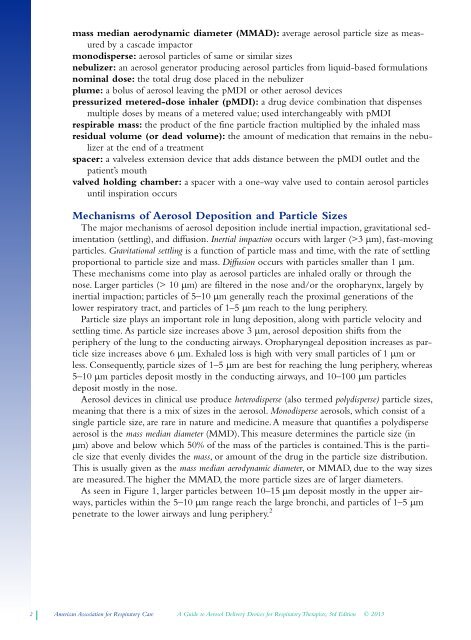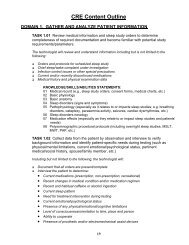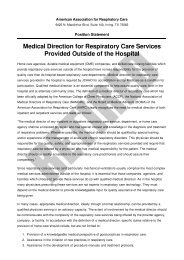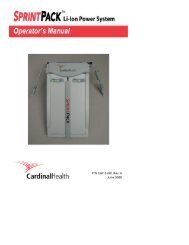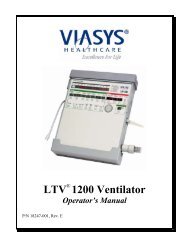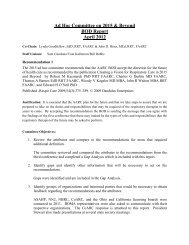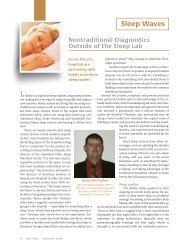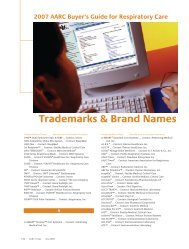Aerosol Guide - AARC.org
Aerosol Guide - AARC.org
Aerosol Guide - AARC.org
You also want an ePaper? Increase the reach of your titles
YUMPU automatically turns print PDFs into web optimized ePapers that Google loves.
mass median aerodynamic diameter (MMAD): average aerosol particle size as measured<br />
by a cascade impactor<br />
monodisperse: aerosol particles of same or similar sizes<br />
nebulizer: an aerosol generator producing aerosol particles from liquid-based formulations<br />
nominal dose: the total drug dose placed in the nebulizer<br />
plume: a bolus of aerosol leaving the pMDI or other aerosol devices<br />
pressurized metered-dose inhaler (pMDI): a drug device combination that dispenses<br />
multiple doses by means of a metered value; used interchangeably with pMDI<br />
respirable mass: the product of the fine particle fraction multiplied by the inhaled mass<br />
residual volume (or dead volume): the amount of medication that remains in the nebulizer<br />
at the end of a treatment<br />
spacer: a valveless extension device that adds distance between the pMDI outlet and the<br />
patient’s mouth<br />
valved holding chamber: a spacer with a one-way valve used to contain aerosol particles<br />
until inspiration occurs<br />
Mechanisms of <strong>Aerosol</strong> Deposition and Particle Sizes<br />
The major mechanisms of aerosol deposition include inertial impaction, gravitational sedimentation<br />
(settling), and diffusion. Inertial impaction occurs with larger (>3 µm), fast-moving<br />
particles. Gravitational settling is a function of particle mass and time, with the rate of settling<br />
proportional to particle size and mass. Diffusion occurs with particles smaller than 1 µm.<br />
These mechanisms come into play as aerosol particles are inhaled orally or through the<br />
nose. Larger particles (> 10 µm) are filtered in the nose and/or the oropharynx, largely by<br />
inertial impaction; particles of 5–10 µm generally reach the proximal generations of the<br />
lower respiratory tract, and particles of 1–5 µm reach to the lung periphery.<br />
Particle size plays an important role in lung deposition, along with particle velocity and<br />
settling time. As particle size increases above 3 µm, aerosol deposition shifts from the<br />
periphery of the lung to the conducting airways. Oropharyngeal deposition increases as particle<br />
size increases above 6 µm. Exhaled loss is high with very small particles of 1 µm or<br />
less. Consequently, particle sizes of 1–5 µm are best for reaching the lung periphery, whereas<br />
5–10 µm particles deposit mostly in the conducting airways, and 10–100 µm particles<br />
deposit mostly in the nose.<br />
<strong>Aerosol</strong> devices in clinical use produce heterodisperse (also termed polydisperse) particle sizes,<br />
meaning that there is a mix of sizes in the aerosol. Monodisperse aerosols, which consist of a<br />
single particle size, are rare in nature and medicine. A measure that quantifies a polydisperse<br />
aerosol is the mass median diameter (MMD). This measure determines the particle size (in<br />
µm) above and below which 50% of the mass of the particles is contained. This is the particle<br />
size that evenly divides the mass, or amount of the drug in the particle size distribu tion.<br />
This is usually given as the mass median aerodynamic diameter, or MMAD, due to the way sizes<br />
are measured. The higher the MMAD, the more particle sizes are of larger diameters.<br />
As seen in Figure 1, larger particles between 10–15 µm deposit mostly in the upper airways,<br />
particles within the 5–10 µm range reach the large bronchi, and particles of 1–5 µm<br />
penetrate to the lower airways and lung periphery. 2<br />
2 American Association for Respiratory Care A <strong>Guide</strong> to <strong>Aerosol</strong> Delivery Devices for Respiratory Therapists, 3rd Edition © 2013


